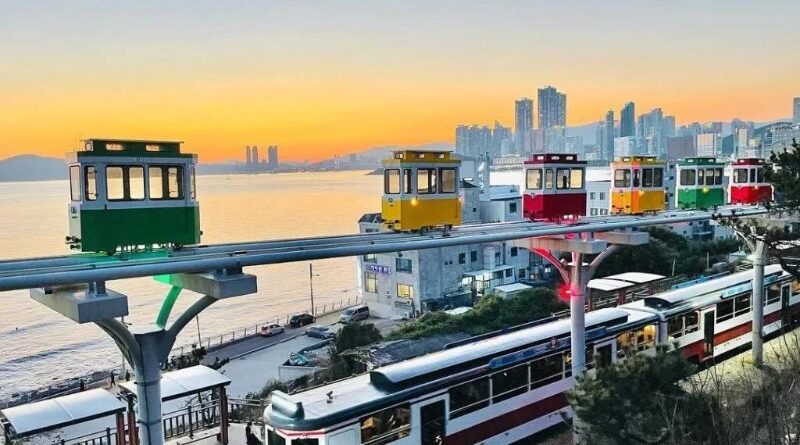Top Best Places to Visit in South Korea
South Korea, a land where tradition meets modernity, offers a diverse range of experiences that will captivate any traveler. From bustling city streets to serene countryside landscapes, this vibrant country is packed with cultural wonders and natural beauty. Whether you’re an adventurer, a history buff, or a food enthusiast, South Korea has something for everyone. So, grab your passport and get ready for a journey through some of the most incredible places to visit in South Korea.
Seoul: A Dynamic Capital City
No trip to South Korea would be complete without a visit to its capital, Seoul. This sprawling metropolis is a blend of ancient palaces, bustling markets, and sleek skyscrapers. Start your adventure in the heart of Seoul with a visit to Gyeongbokgung Palace. This majestic structure, built in 1395, was the main royal palace of the Joseon Dynasty. Don’t miss the Changing of the Guard ceremony, which adds a touch of tradition to your visit.
Just a short walk away is Bukchon Hanok Village, where you can wander through narrow alleyways lined with traditional Korean houses. The area provides a glimpse into Seoul’s past and offers fantastic photo opportunities. For a modern contrast, head over to Myeongdong, one of the city’s busiest shopping districts. Here, you can find everything from trendy fashion boutiques to street food vendors offering mouthwatering treats like tteokbokki (spicy rice cakes) and hotteok (sweet pancakes).
If you’re a fan of panoramic views, make your way to N Seoul Tower. Perched on Namsan Mountain, this iconic landmark provides stunning views of the cityscape, especially at sunset. You can take a cable car or hike up to the tower, making the experience both exhilarating and rewarding.
Seoul is also home to vibrant neighborhoods like Hongdae, known for its youthful energy and lively arts scene. Explore its quirky cafes, indie shops, and street performances. And for a peaceful escape, visit the serene Cheonggyecheon Stream, which runs through the city center and offers a relaxing place to stroll.
Busan: The Coastal Gem
Head southeast from Seoul, and you’ll find yourself in Busan, South Korea’s second-largest city and a coastal paradise. Busan is famous for its beautiful beaches, seafood, and unique cultural experiences. Haeundae Beach is a must-visit destination during the summer months, where you can bask in the sun, swim in the clear waters, or enjoy beachside activities.
For a taste of Busan’s bustling markets, visit Jagalchi Fish Market, the largest seafood market in South Korea. Here, you can sample an array of fresh seafood, from sashimi to grilled fish. The market is not only a culinary delight but also a lively place to experience local life.
Another highlight of Busan is Gamcheon Culture Village, a colorful neighborhood perched on a hillside. The village is renowned for its vibrant murals, artistic installations, and narrow alleyways that wind through charming houses. It’s a fantastic spot for photography and offers a unique perspective on the city’s creative spirit.
For a more tranquil experience, head to Taejongdae Resort Park, located on the southern tip of the city. This natural park features stunning coastal cliffs, lush greenery, and a picturesque lighthouse. It’s an ideal spot for hiking and enjoying the natural beauty of Busan.
Jeju Island: South Korea’s Tropical Paradise
Jeju Island, often referred to as South Korea’s tropical paradise, is a must-visit destination for nature lovers. Located off the southern coast of the Korean Peninsula, Jeju Island boasts stunning landscapes, volcanic formations, and beautiful beaches.
One of the island’s most famous attractions is Hallasan Mountain, a dormant volcano and the highest peak in South Korea. The mountain offers a range of hiking trails that lead through diverse ecosystems, including dense forests and alpine meadows. The views from the summit are breathtaking, making it a rewarding adventure for outdoor enthusiasts.
Another natural wonder on Jeju Island is Seongsan Ilchulbong, also known as Sunrise Peak. This volcanic crater, formed by an underwater eruption, is renowned for its stunning sunrise views. The hike to the top is relatively short but steep, and the panorama of the surrounding landscape is well worth the effort.
Jeju Island is also home to several beautiful beaches, including Jungmun Beach and Hyeopjae Beach. These sandy stretches are perfect for swimming, sunbathing, and enjoying water sports. The island’s unique black lava rocks and turquoise waters create a striking contrast that makes for memorable beach experiences.
To explore Jeju’s cultural heritage, visit the Jeju Folklore & Natural History Museum. The museum offers insights into the island’s traditional way of life, natural history, and folklore. It’s a great place to learn more about Jeju’s unique culture and history.
Gyeongju: The Ancient Capital
Gyeongju, often referred to as the “museum without walls,” is a city steeped in history and ancient heritage. Once the capital of the Silla Kingdom, Gyeongju is home to numerous historical sites and cultural treasures.
Start your exploration at Bulguksa Temple, a UNESCO World Heritage Site renowned for its exquisite architecture and serene surroundings. The temple complex features intricate stone pagodas, ancient statues, and beautiful gardens. Don’t miss Seokguram Grotto, another UNESCO-listed site, which houses a stunning Buddha statue carved into a cave.
Gyeongju’s Ancient Tombs, known as Tumuli Park, is another must-see attraction. The park is dotted with large burial mounds that date back to the Silla Dynasty. The mounds, set against a backdrop of rolling hills, offer a glimpse into the ancient burial practices of the region.
For a unique experience, visit the Cheomseongdae Observatory, one of the oldest astronomical observatories in East Asia. The cylindrical structure, built during the 7th century, was used to observe celestial events and is a testament to the advanced scientific knowledge of the Silla period.
Gyeongju also boasts beautiful traditional hanok houses and charming streets, providing a picturesque setting for leisurely walks and exploration. The city’s rich history and cultural heritage make it a fascinating destination for those interested in South Korea’s ancient past.
Incheon: Gateway to Korea
Incheon, located just west of Seoul, is often seen as the gateway to South Korea due to its international airport. However, the city itself has much to offer beyond its transport connections. Incheon is known for its modern architecture, vibrant cultural scene, and scenic waterfront areas.
One of the highlights of Incheon is Songdo Central Park, a sprawling urban park that features a beautiful lake, walking trails, and modern sculptures. The park offers a relaxing escape from the city and provides opportunities for outdoor activities such as cycling and paddle boating.
Incheon’s Chinatown is another must-visit area, where you can explore the city’s Chinese heritage and enjoy authentic Chinese cuisine. The colorful streets are lined with traditional shops, restaurants, and cultural landmarks, creating a lively and multicultural atmosphere.
For a touch of history, visit Incheon’s historic port area, which played a significant role during the Korean War. The Incheon Landing Operation Memorial Hall commemorates the pivotal Incheon Landing, a key event in the war, and offers insights into this important chapter of Korean history.
Incheon is also home to the stunning Incheon Bridge, an impressive feat of engineering that connects the city to the island of Yeongjong. The bridge offers panoramic views of the surrounding sea and is a symbol of Incheon’s modern development.
Jeonju: A Culinary and Cultural Delight
Jeonju, located in southwestern South Korea, is renowned for its rich culinary traditions and cultural heritage. The city is famous for its delicious bibimbap, a mixed rice dish topped with a variety of vegetables, meat, and a spicy sauce. Jeonju’s version of bibimbap is considered one of the best in the country, and a visit to the city wouldn’t be complete without sampling this iconic dish.
In addition to its culinary delights, Jeonju is home to the Jeonju Hanok Village, a beautifully preserved area featuring traditional Korean houses. The village offers a glimpse into Korea’s past, with its charming hanok buildings, traditional crafts, and cultural performances. You can explore the village’s narrow streets, visit art galleries, and experience traditional Korean tea ceremonies.
Another cultural attraction in Jeonju is the Gyeonggijeon Shrine, dedicated to King Taejo, the founder of the Joseon Dynasty. The shrine is a significant historical site and features beautiful architecture, historical artifacts, and serene gardens.
Jeonju’s vibrant arts scene is also worth exploring, with numerous galleries, craft shops, and cultural events taking place throughout the year. The city’s artistic spirit adds to its charm and makes it a delightful destination for travelers seeking both cultural and culinary experiences.
Conclusion: South Korea Awaits
South Korea is a country that truly has it all—dynamic cities, breathtaking natural landscapes, and a rich cultural heritage. Whether you’re exploring the vibrant streets of Seoul, relaxing on the beaches of Busan, hiking in the volcanic terrain of Jeju Island, delving into ancient history in Gyeongju, discovering modern Incheon, or savoring culinary delights in Jeonju, there’s no shortage of incredible places to visit in South Korea.
Each destination offers its own unique charm and experiences, making South Korea a diverse and exciting travel destination. So, whether you’re planning a short getaway or an extended adventure, South Korea promises an unforgettable journey filled with new discoveries and cherished memories. Happy travels!




